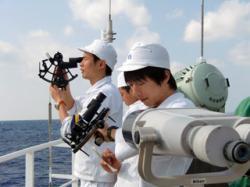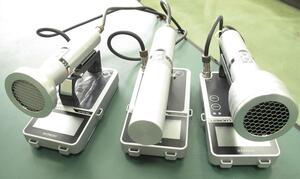Research / social collaborationResearch facilities and equipment
CONTENTSRelated content
Center For Marine Reserch and Operations
In order to operate the university's training ships (3 ships), survey/research ship (1 ship), and training boat (1 ship) safely and with consideration for the marine environment, as well as to support education and research such as experiments and training using the ships, the Center is responsible for 1) the operation of the Center, 2) the operation and safety management of training ships, etc., 3) support for education and research such as experiments and training using training ships, etc., 4) support for observations on training ships, etc., responding to advances in observation technology, and managing observation data, and 5) construction of training ships, etc.

Regarding the use of training ships, etc.
Observation Division
Center For Marine Reserch and Operations
108-8477 Konan, Minato-ku, Tokyo 4-5-7
TEL Operation Department 03-5463-0507
Observation Department 03-5463-0595
External lending of equipment for shared use at Tokyo University of Marine Science and Technology
Tokyo University of Marine Science and Technology offers paid rental of shared equipment to both inside and outside the university.
You can search for devices and apply for user registration via the following URL.
(University members)
https://of.kaiyodai.ac.jp/eq/front.php?cont=user_login
(non-university members)
https://of.kaiyodai.ac.jp/public_eq/front.php?cont=eq_index
(reference)
Shared equipment fee list
Procedures for borrowing (for those not affiliated with the university)
- Please check the information for each piece of equipment at the above link, and then contact the Joint Use Equipment Rental Reception (Research Promotion Division) to inform them that you would like to rent the equipment. (You will need to submit a separate application form.)
- Please meet with the equipment operation manager (to confirm in advance whether the equipment can be used, the date and time of use, etc.).
- Please use the equipment in the presence of a person from our university (excluding cases of entrusted use).
- We will send you an invoice based on the usage record, so please pay the usage fee.
Contact
Tokyo University of Marine Science and Technology Joint use equipment rental reception (Research Promotion Division)
TEL:03-5463-4197
E-Mail: open-facility@m.kaiyodai.ac.jp Reception hours Weekdays 9:00-17:00
Related rules
Tokyo University of Marine Science and Technology Common Use Equipment Rules
Radioisotope Center
To carry out specialized work related to radioisotopes, etc. at the university, and to use them for education and research, and to play a central role in radiation control of radioisotopes, etc. at the university, and to contribute to the progress of education and research. purpose.

Usage guidance
Radiation worker registrationTo engage in radiation work, it is necessary to register as a radiation worker.For registration,
?Participation in education and training
?Special health checkup
is required.
Please inquire at the Radioisotope Control Center for the timing of implementation of education training and special health checkups, and how to apply.
When starting an experiment using radioisotopes, etc., we ask that you submit an "Application for Registration of Handling of Radioisotopes, etc.".
The application form isclick here
personal exposure dosimeterThe Radioactive Isotope Regulation Act requires measurements of exposure doses for those entering controlled areas. At our center, we ask you to wear a glass badge as a dosimeter for measuring external exposure.
entrance/exit cardA dedicated access card is used to enter/exit the center and the management area, and the name of the person entering/exiting, the time of entering/exiting, etc. are recorded.Issuance is accepted at the administration office.
Equipment guide
Research Equipment

-
germanium semiconductor detector
Measure gamma rays from the sample.
There are 3 coaxial type detectors and 1 well type detector. -
NaI scintillation gamma counter
This is a γ-ray detector that uses well-shaped NaI as a detector. -
liquid scintillation counter
This is a low-background type device that mainly measures β-rays. -
Low background type α/β measuring device
This is a 2π gas flow type alpha and beta ray measuring device. -
Scanner type image analyzer
Based on the radiation energy accumulated in the imaging plate,
A device that visualizes the position of a radiation source.
Radiation control equipment

-
Various survey meters
GM tube survey meter
scintillation survey meter
I own a tritium survey meter. -
exhaust equipment
Air supply and exhaust in the controlled area is an all-fresh system.All exhaust is passed through two types of filters, a pre-filter and a HEPA filter, and the radioactivity in the exhaust is constantly measured by a monitor to confirm safety. -
Drainage
All wastewater discharged from controlled areas is temporarily stored in a wastewater tank, and the radioactivity in the wastewater is measured with a monitor to confirm that it is below the legal limit before being discharged.
研究 紹 介
2024
- Teru Miura (2024): Research on the evaluation of cesium-containing fine particles released by the Fukushima Daiichi nuclear power plant accident and their geographical distribution. Doctoral dissertation, University of Tokyo.
2023
- Yoshiyuki Matsushita (2023): Expansion into fresh water and DHA synthesis ability of flatfishes: What is guided by the functional plasticity of DHA synthase. 23rd Marine Biotechnology Society Symposium ``New research on polyunsaturated fatty acid biosynthesis in aquatic organisms'' ``Development'', Ishikawa.
2022
- Ishii, Y.,* Miura, H.,*(*Co-first authors) Jo, J., Tsuji, H., Hayashi, S., Saito, R., Koarai, K., Nishikori, T., Wada , T., Teramoto, W., Sohtome, T., Namba, K., Takahashi, Y. (2022): Radiocesium-bearing microparticles cause a large variation in 137Cs activity concentration in the aquatic insect, Stenopsyche marmorata (Tricoptera: Stenopsychidae ), in the Ota-river, Fukushima, Japan, PLoS ONE, 17(5): e0268629.
2021
- Yoshiyuki Matsushita (2021): Elucidation of the nutritional adaptation mechanism of flatfish fishes entering freshwater: convergent evolution toward acquisition of DHA synthesis ability through diversification of fatty acid metabolizing enzyme systems. Doctoral dissertation, Tokyo University of Marine Science and Technology.
- Teru Miura, Yuichi Kurihara, Yoshio Takahashi (2021): Environmental dynamics of insoluble cesium particles released by the Fukushima Daiichi Nuclear Power Plant accident -Transfer from rivers to the ocean and its effects-, Geochemistry, 55, 122-131.
- Miura, H., Ishimaru, T., Ito, Y., Kurihara, Y., Otosaka, O., Sakaguchi, A., Misumi, K., Tsumune, D., Kubo, A., Higaki, S., Kanda, J., Takahashi, Y. (2021): First isolation and analysis of caesium-bearing microparticles from marine samples in the Pacific coastal area near Fukushima Prefecture, Sci. Rep., 11, 5664.
2020
- Kubo, A., Tanabe, K., Ito, Y., Ishimaru, T., Otsuki, M., Arakawa, H., Watanabe, WY, Miura, H., Tsumune, D., Kanda, J. (2020) ): Changes in radioactive cesium concentrations from 2011 to 2017 in Fukushima coastal sediments and relative contributions of radioactive cesium-bearing microparticles. Mar. Pollut. Bull., 161, 111769.
- Matsushita, Y., Miyoshi, K., Kabeya, N., Sanada, S., Yazawa, R., Haga, Y., Satoh, S., Yamamoto, Y., Strüssmann, CA, Luckenbach, JA, Yoshizaki, G. (2020): Flatfishes colonized freshwater environments by acquisition of various DHA biosynthetic pathways. Commun. Biol., 3, 516.
2019
- Ishimaru, T., Tateda, Y., Tsumune, D., Aoyama, M., Hamajima, Y., Kasamatsu, N., Yamada, M., Yoshimura, T., Mizuno, T., Kanda, J. ( 2019): Mechanism of radiocesium depuration in Sebastes cheni derived by simulation analysis of measured 137Cs concentrations off southern Fukushima 2014-2016.
J. Environ. Radioact., 203, 200-209. - Kubo, A., Tanabe, K., Ito, Y., Ishimaru, T., Arakawa, H., Kanda, J. (2019): Spatial variation in sedimentary radioactive cesium concentrations in Tokyo Bay following the Fukushima Daiichi Nuclear Power Plant accident. 235, 550-555.
2018
- Kubo, A., Tanabe, K., Suzuki, G., Ito, Y., Ishimaru, T., Kasamatsu-Takasawa, N., Tsumune, D., Mizuno, T., Watanabe, WY, Arakawa, H. , Kanda. J. (2018): Radioactive cesium concentrations in coastal suspended matter after the Fukushima nuclear accident. Mar. Pollut. Bull., 131, 341-346.
- Tanabe, K. (2018): Analysis of cesium-rich particles in sediments off the coast of Fukushima Prefecture. Master's thesis, Tokyo University of Marine Science and Technology.
- Kato, Haruka (2018): Analysis of phosphorus circulation in the subtropical western North Pacific using natural radioactive phosphorus. Master's thesis, Tokyo University of Marine Science and Technology.
- Ishimaru, T., Y. Ito, and J. Kanda (2018): Radioactive contamination of coastal ecosystems. 84, 1108.
- Matsushita, Y., Sanada, S., Kabeya, N., Haga, M., Sato, S., Yazawa, R., Yoshizaki, G. (2018): Freshwater migration and DHA synthesis ability of flounder fishes: DHA synthesis pathway of Achilles marine species. Nippon Suisan 30 Spring Meeting of the Society, 226, Tokyo.
- Matsushita, Y., Sanada, S., Kabeya, N., Haga, M., Sato, S., Yazawa, R., Yoshizaki, G. (2018): Freshwater migration and DHA synthesis ability of flounder fishes: Diverse complementary modes of DHA synthesis pathways in freshwater Achilles. 30 Spring Meeting of the Japanese Society of Fisheries Science, 227, Tokyo.
- Matsushita, Y., Sanada, S., Kabeya, N., Haga, Y., Satoh, Satoh, Yazawa, R., Yoshizaki, G. (2018): Creeping Up to Freshwater: Creeping Up to Freshwater: Complusion of the. Dha Biosynthetic Pathway in The Linage of Freshwater Sole (PleuroneCTIFORMES: Achiridae). , 18, Las Palmas de Gran Canaria.
- Teru Miura (2018): Release and migration process of radioactive cesium from the Fukushima nuclear power plant accident: Characteristics of radioactive cesium-containing particles and solid-liquid distribution in rivers. Master's thesis, University of Tokyo.
2017
- Nukui, Iku (2017): Radioactive cesium uptake by marine diatoms. Master's thesis, Tokyo University of Marine Science and Technology.
- Matsushita, Yoshiyuki (2017): Adaptation of freshwater migration and fatty acid metabolic capacity of flounder Acylidae fishes: Elucidation of the DHA synthesis pathway in South American freshwater flatfish Hypoclinemus mentalis. Master's thesis, Tokyo University of Marine Science and Technology.
- Yoshiyuki Matsushita, Shukazu Sanada, Naoki Kabeya, Minoru Haga, Shuichi Sato, Ryosuke Yazawa, Goro Yoshizaki (2017): Freshwater flounder from Papua New Guinea can synthesize DHA from α-linolenic acid. Convention, 29, Tokyo.
- Matsushita, Y., Sanada, S., Kabeya, N., Haga, M., Sato, S., Yazawa, R., Yoshizaki, G. (2017): Freshwater migration and DHA synthesis ability of flounder fishes: duplication of desaturase genes and acquisition of new functions. Spring Meeting of the Japanese Society of Fisheries Science, 28, Tokyo.
2016
- Suzuki, G. (2016): Radioactive cesium in suspended solids off Fukushima Prefecture. Master's thesis, Tokyo University of Marine Science and Technology.
2015
- Naganuma, S. (2015): Analysis based on 137Cs distribution and sediment properties in sediments off the coast of Fukushima Prefecture. Master's thesis, Tokyo University of Marine Science and Technology.
History
| Showa 32/12 |
Establishment of Tokyo University of Fisheries Radioisotope Utilization Facility |
| Showa 42/4 | Modified the irradiation equipment and established a new tracer laboratory. |
| Showa 43/3 | Completion of the Radioisotope Laboratory |
| Showa 45/3 | Increase usage quantity |
| Showa 47/3 | Renamed to "Radioisotope Utilization Facility" |
| Showa 62/3 | Renovated the inside and outside of the building and updated the exterior |
| Heisei 7/12 | Repair of drainage and exhaust equipment |
| Heisei 10/4 | Abolition of Cobalt-60 gamma ray irradiation equipment |
| Heisei 13/3 | Decrease in the number of nuclides used due to the revision of the Radiation Hazards Prevention Act (at that time) |
| Heisei 15/10 |
Tokyo University of Marine Science and Technology was established by merging Tokyo University of Fisheries and Tokyo University of Mercantile Marine. |
| Heisei 29/4 |
Reorganization of the "Radioisotope Utilization Facility", which was an affiliated facility of the Faculty of Marine Science (at that time), into a shared-use facility within the university. |
| September 5 - March 9 |
Complete renovation of usage, storage, and disposal facilities, including the decommissioning of radioactive organic waste incinerators |
Contact
108-8477 Konan, Minato-ku, Tokyo 4-5-7
Tokyo University of Marine Science and Technology Shinagawa Campus Radioisotope Control Center
ri-kanri(at)o.kaiyodai.ac.jp
*Please change (at) to @.





